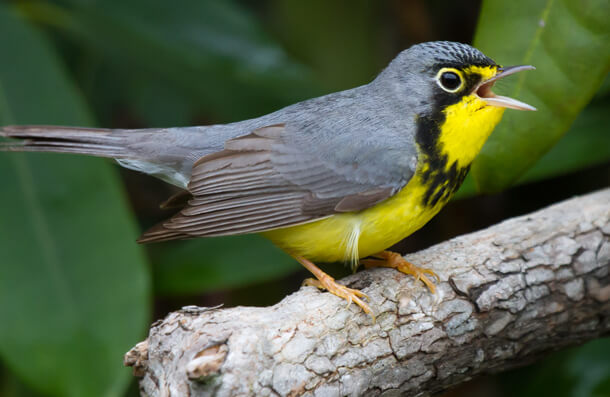Wind Turbines on the Great Lakes Threaten Migratory Birds

Canada Warbler, a species of conservation concern, is one of many migratory songbirds that could be threatened by wind turbines in the Great Lakes region. Photo by Frode Jacobsen
Contact: Michael Hutchins, Director of ABC's Bird-Smart Wind Energy Program, 202-888-7485
(Washington, D.C., Aug. 5, 2016) A radar study released last month by the U.S. Fish & Wildlife Service (FWS) provides stark evidence that wind turbines on the Great Lakes pose an unacceptably high risk to migratory birds and other wildlife. Yet this region in New York has been targeted for enormous wind energy projects, including the proposed Lighthouse Wind facility—one of the nation's 10 worst for birds, according to our recent report.
“This study is the smoking gun in the argument against installing wind energy so close to the lakeshore,” said Dr. Michael Hutchins, Director of American Bird Conservancy's Bird-Smart Wind Energy Program. “If risk to birds means anything to our elected leaders, this should be the death knell to projects like Lighthouse, which is currently under serious consideration by New York's Public Service Commission."
The study, conducted in 2013 and released in July 2016, monitored four sites using radar along the shore of Lake Ontario, scanning 24 hours a day in vertical and horizontal planes to capture movement. At all sites, the radar recorded high levels of bird and bat activity in or near the “rotor-swept zone” that wind turbines would occupy if built along the lakeshore. Activity was especially high at night, a finding that largely invalidates the use of daytime visual surveys often used by wind-energy developers to assess risks to birds.
“The study provides fresh and compelling evidence that wind-energy development does not belong on the shores of the Great Lakes, as ABC, Black Swamp Bird Observatory, and other conservation groups have argued,” said Hutchins. “It confirms what we have long known: In the absence of proven methods to reduce bird collisions with turbines, wind-energy development must be sited in areas where there are fewer birds and bats to minimize harm to these ecologically important animals.”
As the study notes, “Migrants are flying at altitudes that place them at risk of collision with current or future wind energy development in the area. The importance of shoreline areas, as revealed by our study, highlights the need to avoid these migration corridors as recommended in the Service's Land-Based Wind Energy Guidelines.”
The FWS currently recommends that no wind turbines be built within three miles of the Great Lakes' shorelines, while The Nature Conservancy recommends five miles. However, this new radar study suggests that the minimum should be extended even farther, perhaps as far as 10 miles. Unfortunately, the wind industry is eager to build in these sensitive areas.
Given the findings of the FWS radar study, ABC remains highly concerned about the size and location of the proposed Lighthouse project. If approved, up to 71 turbines would be built along the south shore of Lake Ontario in the middle of a migratory corridor used by millions of birds annually. The 570-foot-tall turbines would extend 4.5 miles inland along a 12-mile stretch. Vast numbers of songbirds and raptors concentrate within six miles of the shoreline during spring and fall of each year. This area also has pockets of habitat for sensitive grassland birds, which could be displaced by the turbines. Federally protected Bald Eagles that frequent the area would also be at risk.
“We hope that renewable energy can help address global climate change,” said Hutchins. “But how we do it is very important. We must keep wind and solar projects out of important and sensitive habitats for wildlife. We're not doing a very good job of this now, but with improved regulation and science, leading to proper siting and mitigation, we could make wind energy ‘bird-smart' energy too.”
###
American Bird Conservancy is the Western Hemisphere's bird conservation specialist—the only organization with a single and steadfast commitment to achieving conservation results for native birds and their habitats throughout the Americas. With a focus on efficiency and working in partnership, we take on the toughest problems facing birds today, innovating and building on sound science to halt extinctions, protect habitats, eliminate threats, and build capacity for bird conservation.


















































